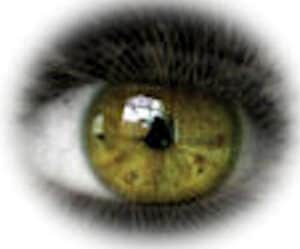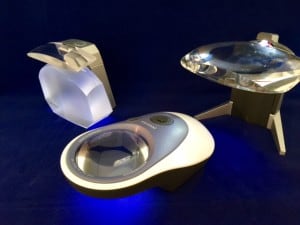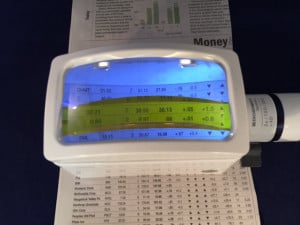Hand-held optical magnifiers come in many styles, sizes, and magnification powers. Commonly, they are sold as either round or rectangular clear lenses, with a handle. Other types include small pocket magnifiers and a plastic ‘card’ style.

The actual amount of magnification that you get form a hand-held magnifier is variable and dependent on how you use it. Optical lenses have an optical property called focal length. If the lens is held above the page, at the focal length, you will get the magnification indicated by the manufacturer. If you hold it closer to the page, at a distance less than the focal length, you will get less magnification. Magnification is also dependent on whether you wear your distance glasses, your bifocals, or no glasses at all.
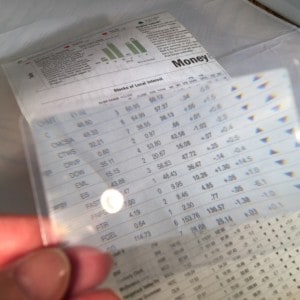
Hand-held magnifiers are best used for short-term viewing, like price tags, product packaging labels, and dials. Holding a magnifier at a consistent distance above the page for long-term reading can be tiring or difficult, especially for someone with hand tremors.
Stand Magnifiers
These are optical lenses that are mounted on some sort of supporting structure, that allows the user to rest the lens on the page they are reading. The stand makes it easier for the user keep the images clear, without hand and arm fatigue. For someone who has hand tremors, the stand magnifier is the better choice. Because of the way the lens is mounted, it may require an awkward head and shoulder position to view through the lens. While this head positioning may limit long-term reading, these lenses are better for scanning the mail, newspaper, or recipes.
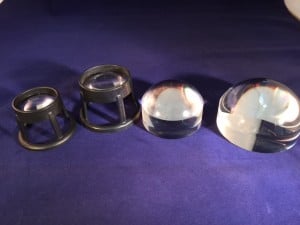
Those with subnormal vision who need a reading prescription should wear it while using a stand magnifier.
Stand magnifiers can have handles like the hand-held magnifier, but the housing around the lens rests on the page . Other types look like a dome paper weight or a horizontal bar that you lay across a line of print.
Stand magnifiers are not found as frequently as hand-held magnifiers in the department store. They can be found at specialty sites or at the low vision office.
Consider the following when selecting a hand-held or stand magnifier:
- Stronger magnification. The stronger the magnification, the thicker the lens, and the thicker lenses tend to be heavier. You might notice the stronger magnifying lenses are smaller because a high-powered hand-held magnifier would be quite heavy to hold. A high powered magnifying lens should have a stand as a support system for the weight of the thicker lens. You will also notice that the smaller, high powered lenses have the smaller field of view.

Illuminated Stand magnifiers - Illuminated. A light source mounted with the lens increases visibility and contrast. Any magnifier with a light will require a power source. Either the user will need to be near a plug or will need to use batteries. The best option are those that have batteries which can be recharged.

Illuminated stand magnifier with line marker - Line markers. This feature helps the low vision user to follow line of print. Usually, the user has the option to flip the line out of view when it is not needed. This feature is found on the more expensive stand magnifiers.
Note regarding magnification rating.
Magnification is rated by the manufacturer in terms of ‘X’ meaning ‘times’ as a multiple of size. Your low vision specialist will uses ‘D,’ which refers to diopter, a unit measure of the optical power of a lens. Loosely, and not entirely accurate, but close enough, 1X is about 4D. So 2X is 8D, 3X is 12D and so on. When it comes to hand-held and stand magnifiers, the magnification may vary and is dependent on how it is used.
